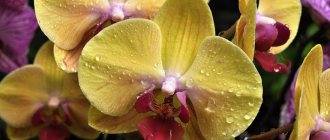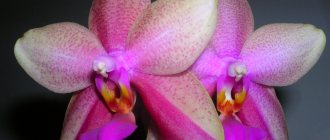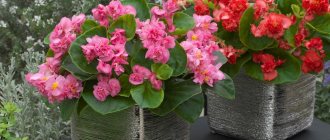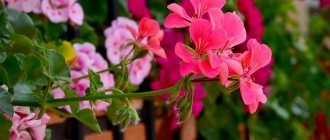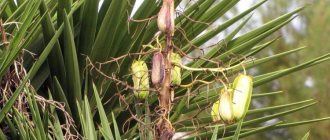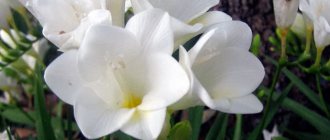What flowers should I give? Roses. Chrysanthemums. What if not for one day? And your choice is an orchid. This will be absolutely true. And many gardeners are increasingly purchasing these amazing flowers for themselves.
It wouldn't be surprising if it was a phalaenopsis.
In this article we will look at phalaenopsis varieties whose names contain the word Gold or Golden.
Anyone who tried to find a phalaenopsis under the specific name Golden managed to get acquainted with many beautiful varieties whose names contain these words.
And they are not always golden or yellow (appealing to your beloved “my golden one” does not mean yellowed). Let's look at them below.
Description and photo
Golden Beauty Orchid (full Latin name Phalaenopsis Sin-Yaun Golden Beauty “Solid Gold”) is an exotic ornamental flowering indoor plant belonging to the ancient orchid family. Its rather large numerous flowers (7-8 cm in diameter) with delicate quivering petals, often of a rich yellow color, and a bright contrasting burgundy core-lip cannot but arouse admiration.
Golden Beauty is reminiscent in shape, like other orchids, of fluttering tropical butterflies , often forming two arched inflorescences, the height of which can reach 80 cm. The abundant, long-lasting flowering of Golden Beauty easily creates an atmosphere of joy, brings a feeling of well-being and luxury.
Detailed description of the Golden Beauty orchid
The flower has all the specific characteristics that allow it to be classified specifically as a phalaenopsis.
The culture has wide, elongated leaves. They are distinguished by their rigidity, fleshiness, skin density and glossiness. The shade is deep green.
Peduncles are standard in height for most phalaenopsis - up to 0.6 m, branched, erect. They grow from the axils, like aerial roots. The stem is short and is lost in the leaf rosette.
Phalaenopsis variety Beauty is unpretentious, blooms magnificently and abundantly. The buds smell pleasant and have a diameter of up to 80 mm. The number of shades is amazing.
Orchids found:
- golden;
- ocher;
- pale pink;
- lilac;
- motley.
The lip is usually distinguished by a contrasting, predominantly crimson or crimson color. Petals can be velvety, matte or waxy.
History of origin
In their natural environment, orchids prefer a humid, saturated tropical climate and can most often be found on trees and rocks in South America, Australia and Southeast Asia.
Around the middle of the 18th century, the orchid became known in Europe. Unfortunately, the “taming” of the flower took more than a century before it was possible to find the right favorable conditions for growing this amazing plant.
Golden Beauty is a new hybrid that was artificially bred by breeders at a time of increased interest among Europeans in plants of this species.
Camellia Middlemist's Red
specialflowersintheworld.blogspot.com
At first glance, Camellia Middlemist Red is difficult to distinguish among other flowers. Of course, its appearance cannot be called ordinary - not every plant can boast such an abundance of buds and splendor of inflorescences. And yet, remembering the incredible abundance of varieties of various ornamental crops, it is difficult to put it at the top of the list of the most beautiful or unusual plants. Moreover, despite the epithet “red”, this plant blooms not even with bright red, but pink flowers. Why is the flowering of this shrub accompanied by a stir among flower lovers?
The fact is that this plant was once widespread in China. It was there at the end of the 19th century that florist John Middlemist noticed it. Transporting plants is not an easy task even in our time, let alone the difficulties that botanists of the past had to face in order to transport and adapt capricious eastern plants to the difficult Western European climate. Nevertheless, the British botanist succeeded. In fact, this unusual plant is named after him.
There are rumors among gardeners that in the vicinity of the English greenhouse of Cheswick House, the same one where John Middlemist brought his flower “trophy,” several more specimens of the unique shrub can be found. They say that the planting material was once shared with local residents either by Middlemist himself, or by greenhouse employees trying to earn extra money.
Another copy of the red Middleista ended up on the other side of the planet - to New Zealand. And while the spreading shrubs of this plant delighted visitors to English and New Zealand greenhouses, the number of middleemites growing in nature was rapidly declining. Experts say that they do not grow at all in their natural habitat. All that remains for you if you want to admire this perhaps the rarest flower on the planet is to go on a trip to the white cliffs of Foggy Albion or the emerald shores of New Zealand.
“Golden” brothers of Golden Beauty
Golden Beauty belongs to the collection of golden orchids , among which the following varieties are the most popular.
Gold Kinabalu
A very expensive and rare variety. It grows only on Mount Kinabalu, located on one of the peninsulas of Malaysia, the first flower appears after 15 years, there is only one peduncle of 6 buds, the orchid has a shorter flowering period.
The petals of this phalaenopsis are more pointed and asymmetrical with brown veins on a yellow background with a darkening in the middle.
Golden Jaguar
The individuality of this variety is given by the spotted core on a soft yellow background.
Golden Rush
Unique and rare species . The flowers have a delicate orange-pink color with veins and a red lip.
Golden Apple
Similar to Golden Rush, but the flowers have predominantly yellow hues, a brighter bud and a pink lip.
gold fish
It has medium-sized orange-pink flowers with veins extending from the base.
Features of an orchid
The Golden Beauty variety is not found in nature. At the same time, there are no anatomical differences between it and natural species.
Our flower, however, has stronger immunity, it quickly adapts to new conditions and is very unpretentious. This allows it to be grown and propagated even by those owners who are not too experienced in the intricacies of keeping phalaenopsis.
Advice: with proper care, Golden Beauty blooms steadily and for a long time, produces a lot of buds and does not cause any special trouble for the owners. However, it is necessary to disturb the orchid less - it does not tolerate overprotection.
How to plant?
You need to decide on the planting capacity, soil and planting method.
Choosing a pot
Orchids love transparent plastic pots ; it is advisable to add side holes for the necessary ventilation of the root system, as is the case in the natural environment for orchids. A stock pot is not required; orchids love small containers suitable for the roots.
What should the soil be like?
You can buy ready-made soil in flower departments or prepare it yourself. It should consist of pieces of bark and charcoal, you can put particles of expanded clay, lowland peat, sphagnum moss. Shells, small particles of pebbles and crushed stone are suitable for drainage.
Step-by-step instruction
- Soak the orchid roots for 5-10 minutes in warm water and carefully remove them from the old container.
- Place drainage material approximately 1-1.5 cm high at the bottom of the new pot.
- Add a layer of charcoal.
- Transfer the plant to a new pot and add the prepared substrate without compaction to the base of growth.
- Secure the peduncle for stability on a long stick installed vertically in the pot using a clothespin.
- Sprinkle moss and bark on top.
- Do not water for 3 days.
Care
Optimal conditions of detention
necessary:
- Place the plant in a bright place without direct sunlight;
- Florists prefer windows on the east side. But Western ones are quite suitable;
- If you want them to bloom, highlight them.
Create the microclimate of their homeland. Maintain the desired temperature and humidity:
- In summer - no higher than 30 degrees. And for the plant, 23-25 degrees is better;
- And in winter it should not be lower than 16-18 degrees.
- Ensure proper and timely watering and fertilizing.
After purchasing in store
- Do I need to replant after purchasing it in a store? Of course it is necessary. The capacity is too small. Sphagnum moss should be replaced with real soil;
- But do this after it has finished blooming.
Step-by-step transplant scheme.
Watering and fertilizing
What needs to be done carefully is watering. But nothing complicated:
- During the flowering period once a week;
- In winter - once every 10 days;
- Choose morning hours.
Watering methods:
- Spraying. To maintain moisture and good flowering, it is recommended even 3-4 times a day. But don't touch the flowers. They may be offended;
- Watering the soil from a watering can;
- Immerse the container halfway in the prepared water. For a couple of hours. And give the water a chance to escape on its own.
Important:
- Monitor the condition of the leaf axils. Water should not stagnate there. Gently wipe the leaves from any drops of water;
- Carry out preventive treatments with a weak solution of potassium permanganate;
- Use distilled water for watering;
- The water temperature should match the air temperature.
Fertilize with fertilizers once every 2 weeks from the beginning of flowering in the summer. In winter, once a month is enough. After flowering, stop feeding. Use Kemira. Plantafol with Megafol. Or special complex fertilizers marked “For orchids”.
Plantafol can be used as a fertilizer.
How to stimulate flowering?
In order not to sit and wait for the orchid to bloom on its own, you can encourage it to do so. This is facilitated by lowering the temperature during the winter months and reducing watering.
Pruning after flowering
Follow the rules of pruning and recommendations for its implementation:
- Select trim time. Take your time to cut immediately after flowering. A flower may bloom on a green peduncle;
- Trim only the wilting and drying parts. Leave a small stump (2-3 cm). Be sure to treat the cut areas;
- The most suitable time is October-November;
- Do this with a clean, disinfected instrument;
- Do not hesitate to consult the flower shops where you purchased these plants.
Prevention of diseases and pests
- He can only blame himself for the occurrence of diseases and pests of phalaenopsis. Even if they brought it from the store or received such a gift;
- Poor quality care and uncomfortable living conditions also introduce diseases: Leaf spot;
- Powdery mildew;
- Fungal diseases and various rots (late blight, anthracnose and others);
- Sunburn;
- All parts can be affected: roots, leaves, flowers.
Powdery mildew on an orchid.
- In addition to sores, pests may also appear (spider mites, aphids, thrips, mealybugs);
- In order not to shout “Guard!”, provide the proper conditions for the plants: This includes temperature, lighting, watering, fertilizing;
- Properly selected containers and soil;
- Ventilation of premises;
- Preventive treatments with fungicides;
- Replacing the substrate.
- Have your own first aid kit for orchids: Fungicides (Fitosporin, Skor, Vectra);
- Potassium permanganate and charcoal;
- Insecticides (Fitoverm, Aktelik);
- Soapy water solutions.
- Be careful and attentive when purchasing in stores. No stains, rust, blisters or damage;
- Quarantine new pets. Separate from everyone.
Orchid care at home
Golden Beauty is unpretentious . It is enough to determine a suitable place for it and plan a watering schedule.
Temperature
- It is optimal to maintain the temperature +20°С…+24°С (Not more than +30°С).
- Sudden changes should be avoided.
- In the autumn-winter season, temperatures of +17 °C…+22 °C are more suitable.
Lighting
Bright lighting is desirable, but without direct sunlight, they can cause burns.
Watering
In winter, the orchid can be watered 2 times a month when completely dry, in summer 1 time a week. There are different methods of watering :
- immersion in warm water for 20 minutes;
- gravy in the pan;
- warm shower.
It is better not to leave water in the pan after watering.
Top dressing
Used as fertilizer:
- mineral complex fertilizers for orchids in strict dosages;
- nitrogen fertilizers for growth;
- potassium and phosphorus during flowering.
Do not fertilize in winter.
Trimming
After flowering, the dried stems of the flower stalks should be trimmed with disinfected scissors, leaving a small shoot.
Transfer
A planned transplant is carried out every 4-5 years, usually in the spring.
Care during the flowering period
During the flowering period, watering of plants is increased, plants are fed with potassium and phosphorus fertilizers.
What to do if it doesn't bloom?
It is necessary to create stressful conditions and provoke flowering:
- cause a drought;
- lower the temperature;
- Move to a dark room for a while.
About flowering
As a rule, an orchid produces buds at least twice a year, but sometimes (under ideal conditions) they appear three times in the same period of time.
Flowering lasts from 1.5 to 3 months. It usually starts in November. In order for the phalaenopsis to release its arrow, it must be cared for especially carefully from the beginning of spring until the end of summer.
During this period it is important:
- carry out proper watering;
- apply fertilizers in a timely manner;
- ensure proper lighting levels.
When flowering is completed, the orchid goes into a dormant state that does not last too long. At this time, it is important not to disturb the culture, because it needs to gain strength to begin a new cycle of life.
Important: after the buds wither, the peduncle is removed. Cut it off with a sterile knife, moving about 20 mm away from the dormant bud. It is advisable to begin treating the latter with a growth stimulator at the same time.
Delayed flowering occurs due to too much care. A little stress will help here. Reduce watering and at the same time ensure that the temperature in the room decreases to +14 °C...+15 °C. After 15 days, restore the usual conditions of detention.
Increasing the difference between day and night temperatures is also considered an effective way. Here you need fluctuations within 4-6 degrees.
Diseases and pests
More often, the reason for the withering of leaves and buds, the formation of mold and burns is the improper maintenance of the orchid, which needs to be reconsidered.
For more serious diseases, treatment is carried out using antibacterial or fungicidal drugs. Viral infection requires isolation from other plants and cannot be treated .
Pests such as spider mites and bulb mites are dangerous for orchids. In this case, a warm shower and spraying with acaricides will help.
It is also recommended to remove all damaged areas of the plant and replant it in a new pot and soil.
Diseases and parasites
An orchid can be attacked by parasites: mealybugs, spider mites and scale insects . If small insects or other changes appear on the flower, it should be washed with warm water and blotted with a gauze swab. If the plant is severely affected, insecticides should be used.
To avoid fungal and viral diseases, it is necessary to maintain sterility during plant transplantation. If you follow all safety measures, your orchids will be healthy and beautiful.
Prevention of various problems
- Maintain temperature conditions.
- Avoid direct sunlight and drafts.
- Disinfect pots and tools with antiseptic agents at the stage of transplanting and propagating orchids.
- Water the flower only when the surface of the soil dries out.
Pay attention to other wonderful types of orchids, detailed descriptions and photos of which you will find in our articles. Read about the unpretentious Cambria, the chic Wanda, the restless Wild Cat, the black beauty Kaode, the mysterious White Heron, the fragrant Vanilla, the many-sided Cymbidium, the delightful Cattleya and the soaring Ghost orchid.
The beautiful golden orchid Golden Beauty can survive up to 14 years in comfortable conditions . By organizing proper care, which is quite simple, you can enjoy its unfading beauty for a long time.
Phalaenopsis varieties Golden Beauty, photo
The Elegant Beauty variety is very interesting. This orchid is distinguished by variegated blooms. The petals are decorated with complex patterns consisting of dark brown dots of different sizes. The main color is soft purple.
Solid gold (Solid Gold) produces two peduncles at once. Their height reaches an average of 0.4 m, but sometimes exceeds 0.8 m. The plant produces medium-sized (about 45 mm) buds of an almost traditional shape for phalaenopsis. Their color is peachy-gold, and the petals are decorated with not too flashy stripes. The culture can bloom for up to 2 months.
Brother Sara Gold (Brother Sara Gold) is another variety of Beauty orchid. This variety has small buds, bright pink in the center and golden towards the edges. Additionally, they are decorated with stripes and small, brick-colored specks.
Gold Leopard produces whimsical, angel-like flowers in a lilac hue. In the center there is a pattern of burgundy dots on an almost white background. The lip is light, with an orange border.
Golden Tresor is a light purple orchid whose petals are decorated with stripes and beige streaks at the tips. The velvety surface of the flowers gives additional charm to phalaenopsis.
These are not all Beauty varieties; there are about twenty-five of them. Unfortunately, it is impossible to describe them all within one article.
Step-by-step care instructions
Selecting a location
Phalaenopsis Beauty loves warmth and light, but the light should be soft and diffused. It is better to place the pots on east and west windows, then direct rays will not harm the leaves.
In hot weather, shade the windows from the scorching sun with tulle or blinds.
In winter and on gloomy autumn days, when, on the contrary, there is not enough sun, use phytolamps, this way you will extend the necessary daylight hours - 10 -12 hours and prevent “freezing” of the roots and leaves.
Preparing the soil and pot
Recommended substrate for Beauty orchid:
- tree bark 1 – 2 cm – 5 hours;
- moss – sphagnum – 2 hours;
- drainage: expanded clay, you can add wine corks, polystyrene foam, so it will be easier for the roots to settle in the pot.
Collectors recommend using this mixture:
- for the drainage system - pebbles or shells, you can use pieces of foam;
- charcoal – 10 hours;
- dry pine bark – 1 tsp.
The substrate should be light, slightly loose, for good air circulation.
For the Beauty orchid, a plastic transparent pot is desirable so that the roots have enough light. You can use special slatted wooden baskets; wood allows moisture and heat to pass through well.
Temperature
Phalaenopsis Beauty loves warmth. The temperature regime has wide limits from 16°C to 25°C.
In summer, the orchid tolerates temperatures of 30 - 32°C, but additional moisture is required. You can pour water into additional containers and place them near the pots. But if the air overheats for a long time, the orchid will begin to act up and may drop its buds. Do not overheat the air.
In winter, the temperature can be lowered to 13°C - 15°C, this will ensure active growth and flowering.
Humidity
The heat-loving Beauty orchid loves moisture; in the summer it is useful to refresh it with spraying. Air humidity should not be lower than 30%, but the flower feels best at 70 - 80% humidity.
If the orchid leaves look limp, you need to nourish the roots. Pots can be placed on pallets with wet expanded clay or pebbles. This procedure will eliminate the problem of pressure in the leaf cells.
Lighting
The Beauty Orchid loves soft light; it will be comfortable on windowsills on the west side; an acceptable place is in the northeast.
In general, if the temperature and humidity meet acceptable standards, the flower will feel great.
It is important to protect the orchid from direct sun, as the leaves may get burned and painful spots will appear on the leaves. If the sun is intense, shade the windows with a light curtain or move the pots away from the window
If the sun is intense, shade the windows with a light curtain or move the pots away from the window.
Watering
In spring and summer, watering should be abundant and regular - 2 times a week. The substrate should not dry out. In winter and autumn, watering is reduced - once a week.
The peculiarity of the Beauty orchid is that it is not fussy about watering. The roots are well nourished by moisture from the air, the main thing is that the room is sufficiently ventilated and humidified.
Phalaenopsis Beauty is watered in several ways:
- Pour water into the tray.
- Water with a shower using warm water.
- They use the immersion method: lower the orchid into a bucket of water for 15–20 minutes so that the substrate is well saturated. Next, you need to let the remaining unnecessary moisture drain into the pan. Be sure to pour out the water from the pan so that the roots do not get wet, this leads to various root diseases.
Top dressing
You need to use only special fertilizers for orchids; if you use fertilizers for other indoor plants, reduce the dose by at least half.
All phalaenopsis use nitrogen fertilizers. Also, the necessary nutritional complex for orchids includes potassium and phosphorus. Solution: 1g. fertilizers per liter of water. Usually the orchid is fertilized along with watering.
Transfer
The Beauty Orchid is painful to transplant. The period of adaptation to new conditions is long, the orchid often gets sick, and growth and development begin to slow down. Therefore, it is necessary to replant no more than once every 2–3 years.
Indications for transplantation:
- The roots had grown greatly and they felt cramped in the old pot.
- The substrate has lost its beneficial properties and has oxidized (a sour smell has appeared).
- The substrate became brittle and brittle.
The transplant procedure is simple and does not require special qualifications of the grower:
- We replant only after flowering.
- Immerse the pot in a container of water to soak the substrate.
- Carefully remove the flower from the pot.
- Using a clean knife, we clean the roots from dead and diseased roots.
- Sprinkle the “wounds” with charcoal or cinnamon.
- Pour drainage into the bottom of the pot.
- We lower the flower into the pot, loosely “seating” the root.
- Sprinkle the substrate on the sides to secure the orchid.
- Gradually fill the pot to the level of the rosette with leaves.
- We refrain from watering for at least 3 days.
Required tools and materials
Regardless of the chosen technique, in order to restore old furniture with your own hands, you will need the following tools and materials:
- Sandpaper of different grits.
- Grinder machine.
- Tools – screwdrivers, wrenches, screwdriver, stapler.
- Construction hairdryer.
- Protective equipment – gloves, goggles, respirator.
- Putty, synthetic or for woodworking.
- Primer for wood or wood-containing materials.
- Selected top coat. This can be stain, varnish, shellac, alkyd or enamel paint of the desired shade, wax. You can choose products for patination, decoupage, craquelure.
- Brushes of various sizes, roller for large surfaces.
Before starting any work, you need to prepare everything you need - buy material, tools. The list consists of the following:
- Furniture fittings;
- Putty material for wood;
- Facades, if necessary;
- Paint or stain (preferably spray);
- Construction knife;
- Construction hair dryer;
- Screwdriver;
- Sharp scissors;
- Iron;
- Self-adhesive furniture film;
- Wax for furniture of different consistency;
- Candle;
- Spatulas;
- Rags, clamp;
- PVA glue;
- Wood varnish;
- Felt pen;
- Edge for processing ends.
Rules for planting and propagating flowers
It is necessary to correctly create conditions for the growth of culture. Its immunity to most diseases, as well as the possibility of flowering, depends on this. If the conditions are not optimal, it will not be possible to achieve it. It is worth considering the nuances in more detail.
Choosing soil and pot
It is necessary to choose the right soil and pot for the plant. Otherwise, it will not be able to grow normally. Here are the main requirements:
- transparent plastic pot;
- good drainage system;
- You can make the soil yourself by mixing tree bark with moss, lowland peat and charcoal.
Planting and pruning
It is necessary to properly plant the orchid. To do this, you need to use the pot and soil indicated above. The planting or transplanting process is standard:
carefully remove the plant from the previous pot so as not to damage the roots; clean the root system of old soil; transplant into a new pot.
Periodically, it is necessary to prune the plant properly. After flowering, the buds dry out. They must be cleaned to prevent pests. Dried branches remaining after flowering are trimmed with a sharp knife or garden shears.
It is worth noting that root rot may appear periodically. It can also be eliminated physically.
Varieties
"Gold of Kinabalu"
This variety of golden orchids is rare and very expensive. This variety grows only on the slopes of Mount Kinabalu, located on one of the peninsulas in Malaysia. The flower of the plant appears when it reaches the age of fifteen. This orchid blooms only for one month (from April to May). Only one peduncle up to 75 centimeters long appears on one plant. There are six buds on it.
The orchid is unpretentious to conditions and can grow both in the shade and in a lighted place. This species is striking in its height (more than 50 centimeters). The leaves are large (from 50 cm in length), yellowish-green in color. Under the sun's rays they completely change their color to yellow. Sheet width – 5 cm.
The sepal located on top is ovoid, pale greenish or yellowish in color with bright red veins. The lower sepal is slightly smaller. The petals are white or yellow with brown stripes and darkening at the base. The edges are curled and covered with villi. Pollination occurs with the help of flies.
One of the subspecies of this plant is fragrant lycasta. It is distinguished by a bright yellow color. You have to wait a long time for this species to bloom. Young growth on the mother plant begins to bloom after a couple of years, and on the young one after five or more years. The seedlings will bloom for the first time after about ten years. The flowers have a diameter of up to 17 cm and exude a sharp, pleasant aroma. The plant grows in the tropics of Central and South America.
"Golden Beauty"
The Phalaenopsis "Golden Beauty" orchid belongs to the oldest genus of orchids. Its homeland is Australia, southern Asia and other places where there is a tropical climate. Even a beginner can grow this species. It is undemanding to care and has many large flowers. On one peduncle their number reaches up to ten. The flowers themselves are yellowish, with a deep red lip. There may be several peduncles; they are slightly curved, because the height sometimes reaches 85 cm.
The plant can bloom for up to two months. The leaves are quite large, hard, as if covered with gloss. The socket is very tight. The shade is dark green. Peduncles and aerial roots are formed from the axils of the leaves.
The main feature of this variety is that it was developed as a result of many crossings. Because of this, the plant is resistant to our conditions (climatic conditions and temperature conditions).
"Golden Jaguar"
This orchid hybrid is well adapted for living indoors. The optimal temperature for it is 21-25°C, at night – 14-17°C. At home, it is almost impossible to ensure such a temperature difference, but at least a difference of a couple of degrees must be observed. The Golden Jaguar does not require high humidity; 40-60 percent is quite enough even during the period of central heating. This species also does not require lighting (plants can develop both in bright light and in the shade). The presence of drafts is harmful to the flower, as is placement on cold window sills.
The petals of this variety are yellow in color and it blooms once every 6 months. Flowering period is 8 weeks. The substrate is suitable as soil, as for all other species. This variety likes to be watered abundantly but sparingly. It is necessary to water when the substrate is completely dry.
Orchids are usually grown in transparent pots, through which drops on the walls are visible. If they are, then it is too early to water.
"Solid Gold"
It usually goes on sale with two peduncles, which appear once every six months. The yellow flowers formed on them delight with their beauty for two months.
To grow this variety, you need a container with a diameter of 10 cm. The plant prefers bright light. He needs average humidity (50-70%). The optimal temperature in summer is 24-29°C, in winter – 19-24°C.
"Golden Rush"
The description of this variety suggests that it is unique and rare. The plant has a pink-orange coloration with veins and a red lip. The flower size in diameter is up to 10 cm. It forms two peduncles. One is covered with flowers and buds. Height - 70 cm. The height of the second is 45 cm. It produces buds during the flowering of the first.
"Golden Apple"
This is another variety of golden orchid. The plant forms a peduncle 55 cm high. The flower size in diameter is up to 9 cm. The flowers have a yellowish-pink color with a bright pink lip. Caring for the plant is the same as for other phalaenopsis.
"Gold fish"
This plant has medium-sized orange-pink flowers with veins radiating from the base. The lower petal is shaped like a lip and is dark pink or orange.
